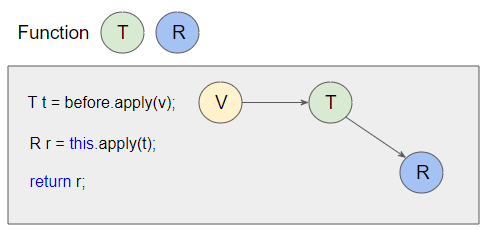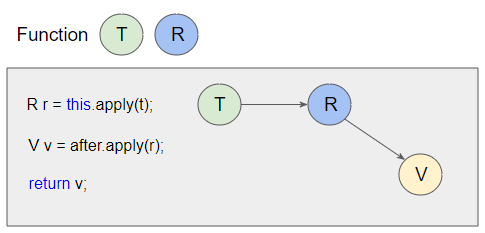Hướng dẫn và ví dụ Java Function
1. Function interface
Trong Java 8, Function là một functional interface, nó đại diện cho một toán tử chấp nhận một giá trị đầu vào và trả về một giá trị.
Mã nguồn của interface Function:
Function interface
package java.util.function;
import java.util.Objects;
@FunctionalInterface
public interface Function<T, R> {
R apply(T t);
default <V> Function<V, R> compose(Function<? super V, ? extends T> before) {
Objects.requireNonNull(before);
return (V v) -> apply(before.apply(v));
}
default <V> Function<T, V> andThen(Function<? super R, ? extends V> after) {
Objects.requireNonNull(after);
return (T t) -> after.apply(apply(t));
}
static <T> Function<T, T> identity() {
return t -> t;
}
}Ví dụ:
FunctionEx1.java
package org.o7planning.ex;
import java.util.function.Function;
public class FunctionEx1 {
public static void main(String[] args) {
Function<String, Integer> func = (text) -> text.length();
int length = func.apply("Function interface tutorial");
System.out.println("Length: " + length);
}
}Output:
Length: 27Ví dụ: Chế biến các phần tử của một đối tượng List để tạo ra một đối tượng List mới.
FunctionEx2.java
package org.o7planning.ex;
import java.util.ArrayList;
import java.util.Arrays;
import java.util.List;
import java.util.function.Function;
public class FunctionEx2 {
public static void main(String[] args) {
Function<String, String> func = text -> text.toUpperCase();
List<String> list = Arrays.asList("Java", "C#", "Python");
List<String> newList = map(func, list);
newList.forEach(System.out::println);
}
public static <T,R> List<R> map(Function<T,R> mapper, List<T> list) {
List<R> result = new ArrayList<R>();
for(T t: list) {
R r = mapper.apply(t);
result.add(r);
}
return result;
}
}Output:
JAVA
C#
PYTHONVí dụ: Sử dụng Function để chuyển đổi một đối tượng List thành một đối tượng Map:
FunctionEx3.java
package org.o7planning.ex;
import java.util.Arrays;
import java.util.HashMap;
import java.util.List;
import java.util.Map;
import java.util.function.Function;
public class FunctionEx3 {
public static void main(String[] args) {
Function<String, Integer> func = text -> text.length();
List<String> list = Arrays.asList("Java", "C#", "Python");
Map<String, Integer> map = listToMap(func, list);
// @see: Map.forEach(BiConsumer).
map.forEach((t,r) -> System.out.println(t + " : " + r));
}
public static <T,R> Map<T,R> listToMap(Function<T,R> mapper, List<T> list) {
Map<T, R> result = new HashMap<T, R>();
for(T t: list) {
R r = mapper.apply(t);
result.put(t, r);
}
return result;
}
}Output:
C# : 2
Java : 4
Python : 6- BiFunction
- IntFunction
- LongFunction
- DoubleFunction
- Supplier
- Predicate
- BiPredicate
- Consumer
- BiConsumer
2. Function + Method reference
M.ref example 1:
Nếu một phương thức tĩnh có một tham số duy nhất và trả về một giá trị, thì tham chiếu của nó có thể coi là một Function.
Function_mref_ex1.java
package org.o7planning.ex;
import java.util.function.Function;
public class Function_mref_ex1 {
public static void main(String[] args) {
// A method of Math class: public static long round(double)
Function<Double, Long> func1 = Math::round; // Method reference
Function<Double, Long> func2 = value -> Math.round(value);
System.out.println(func1.apply(100.7));
System.out.println(func2.apply(100.7));
}
}Output:
101
101M.ref example 2:
Nếu một phương thức không tĩnh (non-static method), không tham số, và trả về một giá trị, thì tham chiếu của nó có thể coi là một Function.
Function_mref_ex2.java
package org.o7planning.ex;
import java.util.function.Function;
public class Function_mref_ex2 {
public static void main(String[] args) {
// A method of String class: public int length()
Function<String, Integer> func1 = String::length; // Method reference
Function<String, Integer> func2 = text -> text.length();
System.out.println(func1.apply("Java")); // 4
System.out.println(func2.apply("Java")); // 4
}
}M.ref example 3:
Tiếp theo, hãy xem lớp CurrencyFormatter dưới đây:
- Phương thức CurrencyFormatter.usd(double) có một tham số kiểu Double và trả về kiểu String, vậy tham chiếu của nó là CurrencyFormatter::usd có thể coi là một Function<Double,String>.
CurrencyFormatter.java
package org.o7planning.tax;
public class CurrencyFormatter {
// Dollar
public static String usd(double amount) {
return "$" + amount;
}
// Euro
public static String euro(double amount) {
return "€" + amount;
}
// Vietnam Dong.
public static String vnd(double amount) {
return amount + "VND";
}
}TaxCalcExample.java
package org.o7planning.tax;
import java.util.function.Function;
public class TaxCalcExample {
public static void main(String[] args) {
double amount = 1000;
String format = formatCurrency("VN", amount);
System.out.println("VN: " + format);
format = formatCurrency("US", amount);
System.out.println("US: " + format);
format = formatCurrency("EU", amount);
System.out.println("EU: " + format);
}
public static String formatCurrency(String countryCode, double amount) {
if ("VN".equals(countryCode)) {
Function<Double, String> formatter = CurrencyFormatter::vnd; // Method reference
return _formatCurrency(formatter, amount);
}
if ("US".equals(countryCode)) {
return _formatCurrency(CurrencyFormatter::usd, amount);
}
if ("EU".equals(countryCode)) {
return _formatCurrency(CurrencyFormatter::euro, amount);
}
throw new RuntimeException("No formatter for " + countryCode);
}
private static String _formatCurrency(Function<Double, String> formatter, double amount) {
return formatter.apply(amount);
}
}Output:
VN: 1000.0VND
US: $1000.0
EU: €1000.03. Function + Constructor reference
Như bạn biết một constructor được sử dụng để tạo ra một đối tượng, nghĩa là nó trả về một giá trị. Vì vậy nếu constructor có một tham số duy nhất thì tham chiếu của nó sẽ được coi là một Function.
Student.java
package org.o7planning.cr;
public class Student {
private String name;
public Student(String name) {
this.name = name;
}
public String getName() {
return name;
}
public void setName(String name) {
this.name = name;
}
}ConstructorReferenceTest.java
package org.o7planning.cr;
import java.util.function.Function;
public class ConstructorReferenceTest {
public static void main(String[] args) {
Function<String, Student> f1 = Student::new; // Constructor Reference
Function<String, Student> f2 = (name) -> new Student(name); // Lambda Expression
System.out.println(f1.apply("Tom").getName());
System.out.println(f2.apply("Jerry").getName());
}
}Output:
Tom
Jerry4. Function Usages
Dưới đây là danh sách các phương thức trong package java.util sử dụng interface Function:
static
<T,U extends Comparable<? super U>> Comparator<T> | Comparator.comparing(Function<? super T,? extends U> keyExtractor) |
static <T,U> Comparator<T> | Comparator.comparing(Function<? super T,? extends U> keyExtractor, Comparator<? super U> keyComparator) |
V | Hashtable.computeIfAbsent(K key, Function<? super K,? extends V> mappingFunction) |
V | HashMap.computeIfAbsent(K key, Function<? super K,? extends V> mappingFunction) |
default V | Map.computeIfAbsent(K key, Function<? super K,? extends V> mappingFunction) |
<U> Optional<U> | |
<U> Optional<U> | |
default
<U extends Comparable<? super U>> Comparator<T> | Comparator.thenComparing(Function<? super T,? extends U> keyExtractor) |
default <U> Comparator<T> | Comparator.thenComparing(Function<? super T,? extends U> keyExtractor, Comparator<? super U> keyComparator) |
5. Function.compose(Function before)
Đây là định nghĩa của phương thức Function.compose:
@FunctionalInterface
public interface Function<T,R> {
R apply(T t);
default <V> Function<V, R> compose(Function<? super V, ? extends T> before) {
Objects.requireNonNull(before);
return (V v) -> apply(before.apply(v));
}
// Other default methods ..
}Và chúng ta viết lại phương thức này theo cách dễ hiểu hơn:
@FunctionalInterface
public interface Function<T,R> {
R apply(T t);
default <V> Function<V, R> compose(Function<? super V, ? extends T> before) {
Objects.requireNonNull(before);
return (V v) -> {
T t = before.apply(v);
R r = this.apply(t);
return r;
};
}
// Other default methods ..
}
Ví dụ:
FunctionEx6.java
package org.o7planning.ex;
import java.util.function.Function;
public class FunctionEx6 {
public static void main(String[] args) {
Function<String, Integer> func = content -> content.length();
Function<Article, String> before = article -> article.getContent();
Article article = new Article("Java Tutorial", "Java Tutorial Content...");
int contentLength = func.compose(before).apply(article);
System.out.println("The length of the article content: " + contentLength);
}
}
class Article {
private String title;
private String content;
public Article(String title, String content) {
this.title = title;
this.content = content;
}
public String getTitle() {
return title;
}
public String getContent() {
return content;
}
}Output:
The length of the article content: 246. Function.andThen(Function after)
Đây là định nghĩa của phương thức Function.andThen:
@FunctionalInterface
public interface Function<T, R> {
R apply(T t);
default <V> Function<T, V> andThen(Function<? super R, ? extends V> after) {
Objects.requireNonNull(after);
return (T t) -> after.apply(apply(t));
}
// Other default methods ..
}Và chúng ta viết lại phương thức này theo cách dễ hiểu hơn:
@FunctionalInterface
public interface Function<T, R> {
R apply(T t);
default <V> Function<T, V> andThen(Function<? super R, ? extends V> after) {
Objects.requireNonNull(after);
return (T t) -> {
R r = this.apply(t);
V v = after.apply(r);
return v;
};
}
// Other default methods ..
}
Ví dụ:
FunctionEx7.java
package org.o7planning.ex;
import java.util.function.Function;
public class FunctionEx7 {
public static void main(String[] args) {
Function<Post, String> func = post -> post.getContent();
Function<String, Integer> after = content -> content.length();
Post post = new Post("Java Tutorial", "Java Tutorial Content...");
int contentLength = func.andThen(after).apply(post);
System.out.println("The length of the post content: " + contentLength);
}
}
class Post {
private String title;
private String content;
public Post(String title, String content) {
this.title = title;
this.content = content;
}
public String getTitle() {
return title;
}
public String getContent() {
return content;
}
}Output:
The length of the post content: 247. Function.identity()
Phương thức tĩnh Function.identity(): Trả về một hàm luôn trả về đối số đầu vào của nó.
static <T> Function<T, T> identity() {
return t -> t;
}Ví dụ: Chuyển đổi một mảng thành một đối tượng Set chứa các phần tử không trùng lặp.
FunctionEx8.java
package org.o7planning.ex;
import java.util.Arrays;
import java.util.Set;
import java.util.function.Function;
import java.util.stream.Collectors;
public class FunctionEx8 {
public static void main(String[] args) {
String[] names = new String[] { //
"Peter", "Martin", "John", "Peter", //
"Vijay", "Martin", "Peter", "Arthur" };
Set<String> set = Arrays.asList(names).stream() //
.map(Function.identity()).collect(Collectors.toSet());
set.forEach(System.out::println);
}
}Output:
Vijay
Arthur
John
Martin
PeterVí dụ ở trên cũng tương đương với ví dụ dưới đây:
FunctionEx8a.java
package org.o7planning.ex;
import java.util.Arrays;
import java.util.Set;
import java.util.stream.Collectors;
public class FunctionEx8a {
public static void main(String[] args) {
String[] names = new String[] { //
"Peter", "Martin", "John", "Peter", //
"Vijay", "Martin", "Peter", "Arthur" };
Set<String> set = Arrays.asList(names).stream() //
.map(t -> t).collect(Collectors.toSet());
set.forEach(System.out::println);
}
}Java cơ bản
- Tùy biến trình biên dịch java xử lý Annotation của bạn (Annotation Processing Tool)
- Lập trình Java theo nhóm sử dụng Eclipse và SVN
- Hướng dẫn và ví dụ Java WeakReference
- Hướng dẫn và ví dụ Java PhantomReference
- Hướng dẫn nén và giải nén trong Java
- Cấu hình Eclipse để sử dụng JDK thay vì JRE
- Phương thức String.format() và printf() trong Java
- Cú pháp và các tính năng mới trong Java 5
- Cú pháp và các tính năng mới trong Java 8
- Hướng dẫn sử dụng biểu thức chính quy trong Java
- Hướng dẫn lập trình đa luồng trong Java - Java Multithreading
- Thư viện điều khiển các loại cơ sở dữ liệu khác nhau trong Java
- Hướng dẫn sử dụng Java JDBC kết nối cơ sở dữ liệu
- Lấy các giá trị của các cột tự động tăng khi Insert một bản ghi sử dụng JDBC
- Hướng dẫn và ví dụ Java Stream
- Functional Interface trong Java
- Giới thiệu về Raspberry Pi
- Hướng dẫn và ví dụ Java Predicate
- Abstract class và Interface trong Java
- Access modifier trong Java
- Hướng dẫn và ví dụ Java Enum
- Hướng dẫn và ví dụ Java Annotation
- So sánh và sắp xếp trong Java
- Hướng dẫn và ví dụ Java String, StringBuffer và StringBuilder
- Hướng dẫn xử lý ngoại lệ trong Java - Java Exception Handling
- Hướng dẫn và ví dụ Java Generics
- Thao tác với tập tin và thư mục trong Java
- Hướng dẫn và ví dụ Java BiPredicate
- Hướng dẫn và ví dụ Java Consumer
- Hướng dẫn và ví dụ Java BiConsumer
- Bắt đầu với Java cần những gì?
- Lịch sử của Java và sự khác biệt giữa Oracle JDK và OpenJDK
- Cài đặt Java trên Windows
- Cài đặt Java trên Ubuntu
- Cài đặt OpenJDK trên Ubuntu
- Cài đặt Eclipse
- Cài đặt Eclipse trên Ubuntu
- Học nhanh Java cho người mới bắt đầu
- Lịch sử của bit và byte trong khoa học máy tính
- Các kiểu dữ liệu trong Java
- Các toán tử Bitwise
- Câu lệnh rẽ nhánh (if else) trong Java
- Câu lệnh rẽ nhánh switch trong Java
- Vòng lặp trong Java
- Mảng (Array) trong Java
- JDK Javadoc định dạng CHM
- Thừa kế và đa hình trong Java
- Hướng dẫn và ví dụ Java Function
- Hướng dẫn và ví dụ Java BiFunction
- Ví dụ về Java encoding và decoding sử dụng Apache Base64
- Hướng dẫn và ví dụ Java Reflection
- Hướng dẫn gọi phương thức từ xa với Java RMI
- Hướng dẫn lập trình Java Socket
- Các nền tảng nào bạn nên chọn để lập trình ứng dụng Java Desktop?
- Hướng dẫn và ví dụ Java Commons IO
- Hướng dẫn và ví dụ Java Commons Email
- Hướng dẫn và ví dụ Java Commons Logging
- Tìm hiểu về Java System.identityHashCode, Object.hashCode và Object.equals
- Hướng dẫn và ví dụ Java SoftReference
- Hướng dẫn và ví dụ Java Supplier
- Lập trình Java hướng khía cạnh với AspectJ (AOP)
Show More
- Hướng dẫn lập trình Java Servlet/JSP
- Các hướng dẫn Java Collections Framework
- Java API cho HTML & XML
- Các hướng dẫn Java IO
- Các hướng dẫn Java Date Time
- Các hướng dẫn Spring Boot
- Các hướng dẫn Maven
- Các hướng dẫn Gradle
- Các hướng dẫn Java Web Services
- Các hướng dẫn lập trình Java SWT
- Các hướng dẫn lập trình JavaFX
- Các hướng dẫn Java Oracle ADF
- Các hướng dẫn Struts2 Framework
- Các hướng dẫn Spring Cloud
